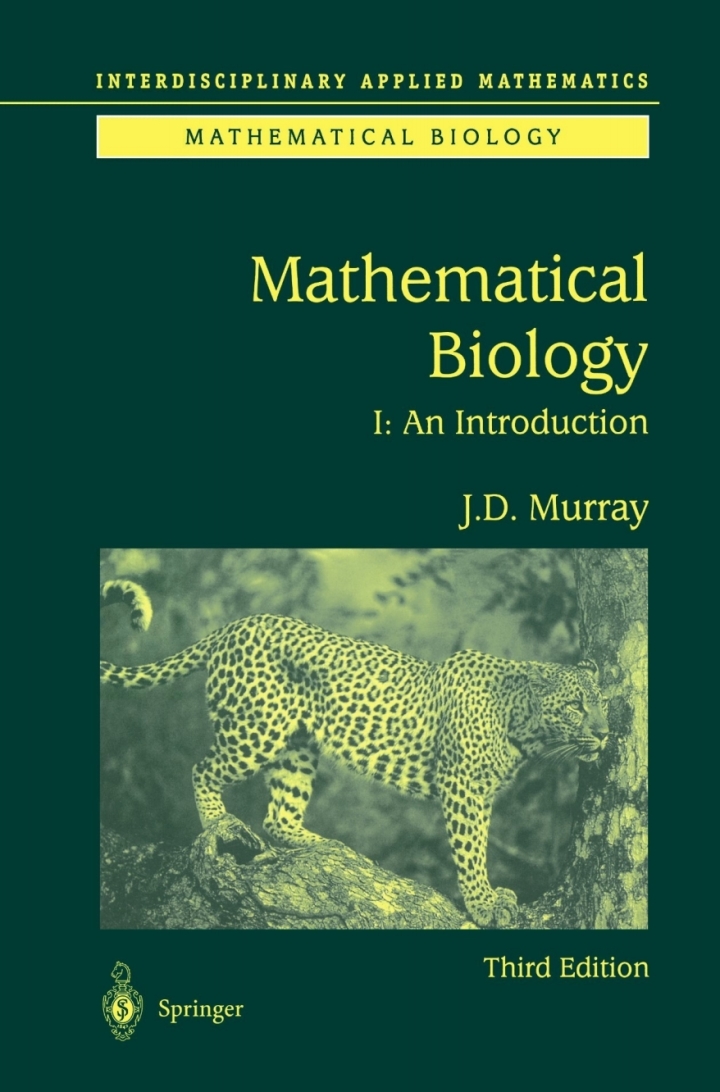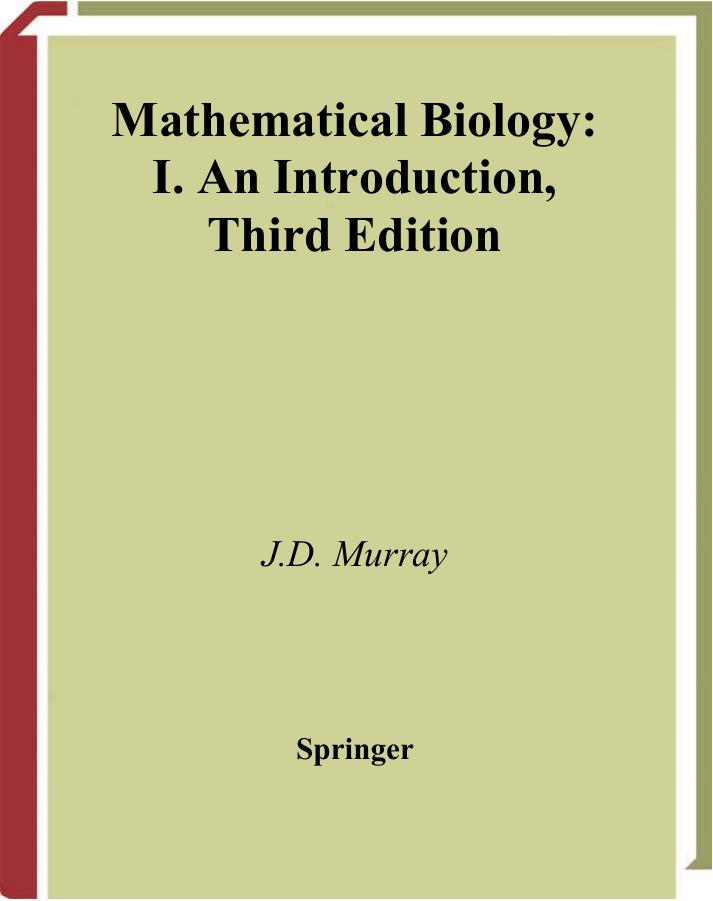Mathematical Biology 1 An Introduction 3rd edition by James Murray ISBN 0387224378 9780387224374
$70.00 Original price was: $70.00.$35.00Current price is: $35.00.
Instant download Mathematical Biology 1 An Introduction after payment
Mathematical Biology 1 An Introduction 3rd edition by James Murray – Ebook PDF Instant Download/Delivery: 0387224378, 9780387224374
Full download Mathematical Biology 1 An Introduction 3rd edition after payment

Product details:
ISBN 10: 0387224378
ISBN 13: 9780387224374
Author: James Murray
It has been over a decade since the release of the now classic original edition of Murray’s Mathematical Biology. Since then mathematical biology has grown at an astonishing rate and is well established as a distinct discipline. Mathematical modeling is now being applied in every major discipline in the biomedical sciences. Though the field has become increasingly large and specialized, this book remains important as a text that introduces some of the exciting problems that arise in biology and gives some indication of the wide spectrum of questions that modeling can address. Due to the tremendous development in the field this book is being published in two volumes. This first volume is an introduction to the field, the mathematics mainly involves ordinary differential equations that are suitable for undergraduate and graduate courses at different levels. For this new edition Murray is covering certain items in depth, giving new applications such as modeling marital interactions andtemperature dependence sex determination. SIAM, 2004: “Murray’s Mathematical Biology is a classic that belongs on the shelf of any serious student or researcher in the field. Together the two volumes contain well over 1000 references, a rich source of material, together with an excellent index to help readers quickly find key words. … I recommend the new and expanded third edition to any serious young student interested in mathematical biology who already has a solid basis in applied mathematics.”
Mathematical Biology 1 An Introduction 3rd Table of contents:
Part I: Continuous Population Models for Single Species
- Continuous Growth Models
- Insect Outbreak Model: Spruce Budworm and Catastrophes in Perception
- Delay Models
- Linear Analysis of Delay Population Models: Periodic Solutions
- Delay Models in Physiology: Periodic Dynamic Diseases
- 5.1 Cheyne–Stokes Respiration
- 5.2 Regulation of Haematopoiesis
- Harvesting a Single Natural Population
- Population Model with Age Distribution
Exercises
Part II: Discrete Population Models for a Single Species
- Introduction: Simple Models
- 1.1 Fibonacci Sequence
- Cobwebbing: A Graphical Procedure of Solution
- Discrete Logistic-Type Model: Chaos
- Stability, Periodic Solutions, and Bifurcations
- Discrete Delay Models
- 5.1 Chaos and Data
- Fishery Management Model
- Ecological Implications and Caveats
- Tumour Cell Growth
Exercises
Part III: Models for Interacting Populations
- Predator–Prey Models: Lotka–Volterra Systems
- Complexity and Stability
- Realistic Predator–Prey Models
- Analysis of a Predator–Prey Model with Limit Cycle Periodic Behaviour: Parameter Domains of Stability
- Competition Models: Principle of Competitive Exclusion
- Mutualism or Symbiosis
- General Models and Some General and Cautionary Remarks
- 7.1 Lake Victoria and the Nile Perch Catastrophe 1960
- Threshold Phenomena
- Discrete Growth Models for Interacting Populations
- Predator–Prey Models: Detailed Analysis
- 10.1 Density-Dependent Predator–Prey Model
- 10.2 Biological Pest Control: General Remarks
Exercises
Part IV: Temperature-Dependent Sex Determination (TSD): Crocodilian Survivorship
- Biological Introduction and Historical Asides on the Crocodilia
- Basic Nesting Assumptions and Simple Population Model
- Age-Structured Population Model for the Crocodilia
- Density-Dependent Age-Structured Model Equations
- 4.1 Birth and Death Data
- Stability of the Female Population in the Wet Marsh Region I
- Sex Ratio and Survivorship
- Temperature-Dependent Sex Determination (TSD) Versus Genetic Sex Determination (GSD)
- Related Aspects on Sex Determination
Exercise
Part V: Modelling the Dynamics of Marital Interaction: Divorce Prediction and Marriage Repair
- Psychological Background and Data: Gottman and Levenson Methodology
- 1.1 Observational Coding
- Marital Typology and Modelling Motivation
- Modelling Strategy and the Model Equations
- 3.1 Estimation of Parameters and the Influence Functions
- Steady States and Stability
- 4.1 Influence Functions
- 4.2 Mismatch Theory: The Possibility that Unstable Marriages Are the Results of Failed Attempts at Creation
- Practical Results from the Model
- 5.1 Steady States and Inertia
- 5.2 Low Risk Couples
- 5.3 High Risk Couples
- 5.4 Parameters and Divorce Prediction
- Benefits, Implications, and Marriage Repair Scenarios
Part VI: Reaction Kinetics
- Enzyme Kinetics: Basic Enzyme Reaction
- Transient Time Estimates and Nondimensionalisation
- Michaelis–Menten Quasi-Steady State Analysis
- Suicide Substrate Kinetics
- 4.1 Nondimensional Form
- 4.2 Inner or Singular Solutions
- 4.3 Outer or Quasi-Steady State Solutions
- 4.4 Uniformly Valid Solution for All Time
- 4.5 Numerical Solutions and Comparison with Analytic Solutions
- Cooperative Phenomena
- Autocatalysis, Activation and Inhibition
- Multiple Steady States, Mushrooms, and Isolas
- 7.1 Mushrooms
- 7.2 Isolas
- 7.3 Iodate–Arsenous Acid Reaction: Bistability, Mushrooms, Isolas
Exercises
Part VII: Biological Oscillators and Switches
- Motivation, Brief History, and Background
- Feedback Control Mechanisms
- Oscillators and Switches Involving Two or More Species: General Qualitative Results
- 3.1 Canards
- Simple Two-Species Oscillators: Parameter Domain Determination for Oscillations
- 4.1 Determination of Parameter Space for Oscillations
- 4.2 λ − ω Systems
- Hodgkin–Huxley Theory of Nerve Membranes: FitzHugh–Nagumo Model
- 5.1 Basic Mathematical Model
- 5.2 Periodic Neuron Firing
- Modelling the Control of Testosterone Secretion and Chemical Castration
- 6.1 Chemical Castration
Exercises
- 6.1 Chemical Castration
Part VIII: BZ Oscillating Reactions
- Belousov Reaction and the Field–Körös–Noyes (FKN) Model
- Linear Stability Analysis of the FKN Model and Existence of Limit Cycle Solutions
- Nonlocal Stability of the FKN Model
- Relaxation Oscillators: Approximation for the Belousov–Zhabotinskii Reaction
- Analysis of a Relaxation Model for Limit Cycle Oscillations in the Belousov–Zhabotinskii Reaction
Exercises
Part IX: Perturbed and Coupled Oscillators and Black Holes
- Phase Resetting in Oscillators
- Phase Resetting Curves
- 2.1 Type 1 Phase Resetting Curves
- 2.2 Type 0 Phase Resetting Curves
- Black Holes
- Black Holes in Real Biological Oscillators
- Coupled Oscillators: Motivation and Model System
- Phase Locking of Oscillations: Synchronisation in Fireflies
- Singular Perturbation Analysis: Preliminary Transformation
- Singular Perturbation Analysis: Transformed System
- 8.1 Limit Cycle Stability Condition for the Uncoupled Oscillators
- Singular Perturbation Analysis: Two-Time Expansion
- Analysis of the Phase Shift Equation and Application to Coupled Belousov–Zhabotinskii Reaction
Exercises
Part X: Dynamics of Infectious Diseases: Epidemic Models and AIDS
- Historical Aside on Epidemics
- 1.1 Bombay Plague Epidemic 1905–1906
- 1.2 Influenza Epidemic in an English Boarding School 1978
- 1.3 Plague in Eyam, England 1665–1666
- Simple Epidemic Models and Practical Applications
- Modelling Venereal Diseases
- Multi-Group Model for Gonorrhea and Its Control
- AIDS: Modelling the Transmission Dynamics of the Human Immunodeficiency Virus (HIV)
- 5.1 Background, Myths, Statistics, and Polemics
- 5.2 Human Immunodeficiency Virus (HIV)—Background
- 5.3 Basic Epidemic Model for HIV Infection in a Homosexual Population
- HIV: Modelling Combination Drug Therapy
- 6.1 T-Cell Recovery
- Delay Model for HIV Infection with Drug Therapy
- 7.1 Time Lags in the HIV Infection Process
- Modelling the Population Dynamics of Acquired Immunity to Parasite Infection
- Age-Dependent Epidemic Model and Threshold Criterion
- Simple Drug Use Epidemic Model and Threshold Analysis
- Bovine Tuberculosis Infection in Badgers and Cattle
- 11.1 Criss-Cross Model System for Bovine Tb
- 11.2 Parameter Estimation
- 11.3 Numerical Results and Predictions
- Modelling Control Strategies for Bovine Tuberculosis in Badgers and Cattle
- 12.1 Criss-Cross Model with Immunization
- 12.2 Control Programme and Its Implementation
- 12.3 Cellular Automaton Model for Practical Implementation
- 12.4 BSE (Bovine Spongiform Encephalopathy) and Creutzfeldt–Jacob (CJ) Disease
Exercises
Part XI: Reaction Diffusion, Chemotaxis, and Nonlocal Mechanisms
- Simple Random Walk and Derivation of the Diffusion Equation
- Reaction Diffusion Equations
- Models for Animal Dispersal
- Chemotaxis
- Nonlocal Effects and Long Range Diffusion
- Cell Potential and Energy Approach to Diffusion and Long Range Effects
Exercises
Part XII: Oscillator-Generated Wave Phenomena and Central Pattern Generators
- Kinematic Waves in the Belousov–Zhabotinskii Reaction
- Central Pattern Generator: Experimental Facts in the Swimming of Fish
- Mathematical Model for the Central Pattern Generator
- 3.1 Single Oscillator and Oscillator Pair
- 3.2 Sequence of Coupled Oscillators
- Analysis of the Phase Coupled Model System
- 4.1 Two-Oscillator System
- 4.2 Three-Oscillator System
- 4.3 Constant Phase Lag System of N-Oscillators
Exercises
Part XIII: Biological Waves: Single-Species Models
- Background and the Travelling Waveform
- Fisher–Kolmogoroff Equation and Propagating Wave Solutions
- Asymptotic Solution and Stability of Wavefront Solutions of the Fisher–Kolmogoroff Equation
- Density-Dependent Diffusion-Reaction Diffusion Models and Some Exact Solutions
- 4.1 Brief Derivation of the Wavespeed Dispersion Relation
- Waves in Models with Multi-Steady State Kinetics: Spread and Control of an Insect Population
- Calcium Waves on Amphibian Eggs: Activation Waves on Medaka Eggs
- Invasion Wavespeeds with Dispersive Variability
- 7.1 Relative Sizes of Subpopulations
- Species Invasion and Range Expansion
Exercises
Part XIV: Use and Abuse of Fractals
- Fractals: Basic Concepts and Biological Relevance
- 1.1 Biological Examples
- Examples of Fractals and Their Generation
- Fractal Dimension: Concepts and Methods of Calculation
- 3.1 Dimension of a Self-Similar Fractal and Scaling Laws
- 3.2 Non Self-Similar Fractals and the Box-Counting Dimension
- Fractals or Space-Filling?
- 4.1 Caveat
Appendices
- Appendix A: Phase Plane Analysis
- Appendix B: Routh–Hurwitz Conditions, Jury Conditions, Descartes’ Rule of Signs and Exact Solutions
- Appendix B.1: Characteristic Polynomials, Routh–Hurwitz Conditions and Jury Conditions
- Appendix B.2: Descartes’ Rule of Signs
- Appendix B.3: Roots of a General Cubic Polynomial
Bibliography
Index
People also search for Mathematical Biology 1 An Introduction 3rd:
what is the introduction of biology
what is biology 1 and 2
what is biology 1
mathematical biology i. an introduction pdf
introduction to mathematical biology
Tags:
James Murray,Mathematical Biology,An Introduction



